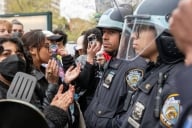You have /5 articles left.
Sign up for a free account or log in.

Istockphoto.com/cglade
LOUISVILLE, Ky. -- With colleges and universities enrolling more and more early-decision applicants, a panel of experts at the National Association for College Admission Counseling’s national conference last month convened to answer the question of who, exactly, is benefiting.
Panelists didn’t disagree -- the privileged are benefiting. That includes students privileged enough to be thinking about college early in their high school careers and privileged enough to able to pledge to accept admission to a college without seeing its financial aid offer first. It also includes colleges that are privileged enough to attract students willing to enroll under early-decision terms.
The panelists spent most of their time discussing related questions: what to do about early decision and whether an admissions mechanism catering to the interests of the best-off institutions and students can be harnessed to serve a greater good.
“We think schools benefit,” said Kirk Brennan, director of admission at the University of Southern California, which does not offer an early-decision option to applicants. “The privileged also benefit. We hope to focus on learning, focus on education for its own sake. High school is not just a way to get into college. It’s a way to grow and become a strong, educated citizen.”
Early decision is a binding admissions option under which students commit to a college or university that they consider to be their first choice. Students agree to enroll in that college if admitted and withdraw applications to any other colleges. Application deadlines and deadlines by which students decide to enroll come earlier under early decision than they do under standard admission. At its national conference, NACAC relaxed rules for incentivizing early-admission applications under pressure from a U.S. Department of Justice antitrust investigation.
Early decision has been on the rise in higher education. From the fall of 2016 to the fall of 2017, the number of early-decision applicants increased by 4 percent, according to NACAC’s latest "State of College Admission" report. The number of early-decision admissions increased slightly more, by 5 percent. Between fall 2015 and fall 2016, early-decision applicants and early-decision admissions both increased by 6 percent.
Tulane University announced in April 2016 that it would be adding an early-decision option for its next applicant pool. The university hadn’t had an early-decision option since Hurricane Katrina flooded campus in 2005, prompting the university to be shut down for a semester. But Tulane grew in popularity over the years, and “with that popularity comes some decisions,” said Jeff Schiffman, director of admission.
Between 2015 and 2019, the number of students applying to Tulane has spiked by 61 percent to more than 42,000, Schiffman said. In 2015, Tulane had a 30 percent admit rate. In 2019, its admit rate had fallen below 13 percent.
Marketers, university board members, presidents and parents all love to see such numbers.
“I cringe every time Tulane shares how excited we are about how low our admit rate is, but PR offices love this stuff,” Schiffman said. “You share this chart with parents at the Dalton School -- well, all of a sudden we’re not the safety school for Vanderbilt.”
With so many students angling for a limited number of seats, how do admissions officers decide which students truly want to enroll? Early decision helps, Schiffman said.
In 2015, Tulane’s yield -- the percentage of students admitted who actually enrolled -- was 21 percent. It’s now all the way up to 34 percent.
Early decision can also help universities control the amount of non-need-based aid they offer to students, meaning they can collect more net tuition revenue from students from wealthy families. That in turn can allow some institutions to dedicate more money for need-based aid and meet more of poor students’ financial need.
But there are costs, Schiffman said. He read an email from the father of a student admitted through early decision. Three months after the ink was dry on the early-decision contract, the father was dangling financial aid offers from other institutions in an attempt to win more financial aid from Tulane.
“Is the dad wrong?” Schiffman asked. “Yes. But have I created this mania where his daughter felt like she had to apply ED to get in, and now they’re trying to apply financial aid leverage? I don’t know the answer to that question.”
He also didn’t know if the daughter would have been admitted through other admissions procedures. Therein lies another criticism of early decision: early-decision applicants, who tend to be white and wealthy, are accepted at higher rates than regular applicants.
Early-decision applicants were accepted 62 percent of the time, according to NACAC’s most recent "State of College Admission." All applicants at colleges with early decision were admitted just 51 percent of the time. Average yield rates for early-decision admits came in at 88 percent, far above the yield rate for all students admitted to colleges offering early decision, which was just 26 percent.
Transparency was Schiffman’s answer to the questions early decision raises. He’s posted public blog posts running through every way a student can apply and be admitted to Tulane. No president is going to endorse a higher admission rate next year, so it’s unlikely any will do away with early decision.
“I know that this big ED animal is not always the easiest pill for you all to swallow,” Schiffman said. “What I can tell you is, the more schools can be transparent about this process, the more we can meet you all halfway.”
Brennan, of the University of Southern California, admitted it is tempting to use early decision to meet enrollment goals. But he is concerned that early decision creates a false sense among students that a quality education might be out of reach if they don’t give up their ability to evaluate multiple financial aid offers in order to lock in a seat early.
“In our view the problems outweigh the benefits,” he said. “The sense of scarcity is created, manufactured, by early-decision programs. The supply and demand is fairly constant. I don’t like the idea of asking students to give up their freedom to choose. To me it feels like an abuse of power.”
High school students are still growing and changing, Brennan said. To ask them to declare their first choice of a college at the end of their junior year does not sit well with him. He also brought up concerns that early decision advantages some student groups over others.
“We exacerbate a system rooted in preserving access to power, perhaps a system of white supremacy,” he said. “I’m not that sure early decision is an antiracist policy.”
Early decision can also reinforce a sense that students are guaranteed what they want. But they can’t always have what they want, Brennan said. Colleges and admissions offices should instead be finding ways to encourage students to think more broadly about their opportunities.
Brennan hears colleagues talk privately about how little room is left in the regular decision process because admissions officers are pressured to lock in large chunks of a class early.
“The pressures to add an early portion of the class leave little room for good students who don’t have hooks,” he said. “Frankly, even using the word 'hook' doesn’t feel right to me. I don’t think we’re trying to bait.”
Brennan’s position as a critic of certain admissions processes is notable because of his position at USC, which has found its name closely associated with the Varsity Blues admission bribery scandal. In fact, he was one USC official whose emails were published in the press after they were made public as part of the legal back-and-forth in the case.
The market in which a university competes might influence whether it offers early decision. Brennan acknowledged that “it is in some way easy for us to hold firm on principle” because USC’s primary competitors are the University of California, Los Angeles, and UC Berkeley. Neither offers early decision for undergraduates.
Two high school counselors also took part in the discussion. Both were from schools serving relatively wealthy students -- Elise Rodriguez is director of college counseling at the Dalton School, and Joanne Lewis is director of the college and career center at Palos Verdes High School in California, which has senior classes of roughly 400 students.
But the Dalton School is a much more affluent, high-touch environment than almost any public high school. Rodriguez is one of three college counselors for a class of 110.
Rodriguez was up front about who early decision benefits: her and her students. Students feel immense pressure to get into the best possible college or university, she said. They can’t imagine waiting through the regular decision process and not knowing where they will go to college until the spring of their senior years of high school.
“They just want this to be over in their minds,” she said. “And, honestly, so do their parents. Their parents are driving a huge part of this pressure to be done, as well as to get into the best possible school.”
Palos Verdes serves a relatively well-off population but does not have many students applying through early decision.
“The vast majority of our families cannot pay the money,” Lewis said. “We do have the conversation of, ‘This is a binding agreement, you are agreeing that you understand what this is going to cost you. You cannot compare financial aid packages.’ And I will say that does hit home with our families.”
It also reinforces which class of students truly has access to college through early decision.
“If a fairly affluent school like Palos Verdes High School is not attracting the ED students, I have to really wonder what all of those underresourced schools with no college and career center -- I really have to wonder if there is any, any concept or ability to go early decision,” Lewis said. “We talk about access. Wow. I think we need to be cognizant of that.”
Just over a fifth of respondents to NACAC’s 2017-18 Admission Trends Survey, 21 percent, offered early decision. Far more privates, 30 percent, had early-decision options than publics, 6 percent. Over half of the most selective colleges, 52 percent, offered students an early-decision option.
Just 5 percent of applications for the fall of 2017 came through early decision. But, NACAC research has noted, “the proportion of applicants received through ED increased with the admission selectivity rate and yield rate.”
Also, colleges with lower total yield rates tended to admit a greater percentage of their students applying under early decision than did those with higher yield rates, NACAC’s research has said. “More selective colleges tended to have higher ED yield rates.”








